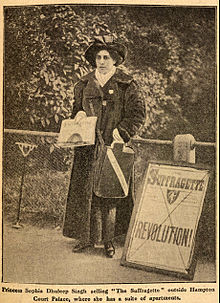Sophia Duleep Singh

Princess Sophia Alexandra Duleep Singh (born August 8, 1876 in Elveden , Forest Heath , England; died August 22, 1948 in Tylers Green , Buckinghamshire , England) was a British suffragette .
Life
Sophia Duleep Singh was a granddaughter of the Sikh ruler Ranjit Singh , who was forced to abdicate by the British, and a daughter of the Maharajah Duleep Singh , who grew up and lived in exile in Great Britain. Her mother was the Maharani Bamba Müller , her godmother was Queen Victoria . Her mother died in 1887 and her father married a second time; he died in 1893, leaving each of his nine children a considerable trousseau. In 1895 Sophia Duleep Singh and two of her four sisters made her debut at court at Buckingham Palace . Queen Victoria granted her the right to live in Faraday House on the Hampton Court Palace estate in 1898 .
In 1903 and 1907 she visited India and made the acquaintance of Indian independence fighters there such as Gopal Krishna Gokhale and Lala Lajpat Rai . Her brothers were prevented from traveling to India by the colonial power for political reasons. In 1909 she was promoted by Una Dugdale for the Women's Social and Political Union (WSPU) and from then on campaigned for women's suffrage. She spoke at public events and organized donations. She supported the Women's Tax Resistance League (WTRL) and was repeatedly fined for refusing to pay taxes , but the English judiciary avoided imprisoning the princess for political reasons. In order to collect the taxes, jewelry was confiscated from her and publicly auctioned. The auctions were used by the WTRL as a public tribunal for women's suffrage. On November 18, 1910, Black Friday , she took part in a women's demonstration march to the House of Commons led by Emmeline Pankhurst . The women were forcibly pushed back by the police on the orders of the Interior Minister and some were seriously injured. Duleep Singh had himself photographed outside Hampton Court in 1913 while the Suffragette newspaper was on the street . In 1915 she took part again in a demonstration by workers. Census suffrage for women was introduced in Great Britain in 1918, and universal suffrage for women existed from 1928.
During the First World War , Duleep Singh volunteered as a Red Cross nurse and took care of injured Indian soldiers in the British Army in England. In 1924 she went to India again to support the Indian suffragette movement, which was partially successful in the 1920s; universal suffrage only came with Indian independence in 1947.
Duleep Singh was a member of the "Suffragette Fellowship" until her death. Her older sister Princess Catherine Hilda Duleep Singh (1871-1942) was also active in the WSPU. She lived in a lesbian relationship in Germany in Kassel-Mulang from the 1920s until the November pogroms in 1938 , when she had to return to England because of German racism . Sister Bamba returned to Lahore and, as the "Queen of Punjab", caused unrest in the British colonial administration.
literature
- Anita Anand : Sophia: Princess, Suffragette, Revolutionary . New York: Bloomsbury, 2015 ISBN 9781408835456 (not accessed )
- Rozina Visram: Duleep Singh, Princess Sophia Alexandra (1876–1948) , in: Oxford Dictionary of National Biography , Oxford University Press online
Web links
- Literature by and about Sophia Duleep Singh in the bibliographic database WorldCat
Individual evidence
- ↑ Susan Kingsley Kent: Sex and suffrage in Britain 1860-1914 . Princeton, NJ: Princeton Univ. Pr., 1987, pp. 173f.
- ↑ June Hannam; Mitzi Auchterlonie; Katherine Holden: International encyclopedia of women's suffrage . Santa Barbara, California: ABC-Clio, 2000, pp. 137-139
- ↑ Princess Catherine Hilda Duleep Singh (1871-1942) at ODNB, doi : 10.1093 / ref: odnb / 105619
- ^ Maria Misra: High-society suffragette . Review, in: Financial Times , January 10, 2015, p. 9
| personal data | |
|---|---|
| SURNAME | Duleep Singh, Sophia |
| ALTERNATIVE NAMES | Dalip Singh, Sophia; Duleep Singh, Sophia Alexandrovna |
| BRIEF DESCRIPTION | British suffragette |
| DATE OF BIRTH | August 8, 1876 |
| PLACE OF BIRTH | Elveden , Forest Heath , England |
| DATE OF DEATH | August 22, 1948 |
| Place of death | Tylers Green , Buckinghamshire , England |
